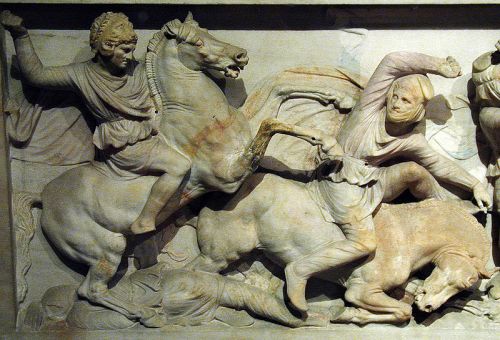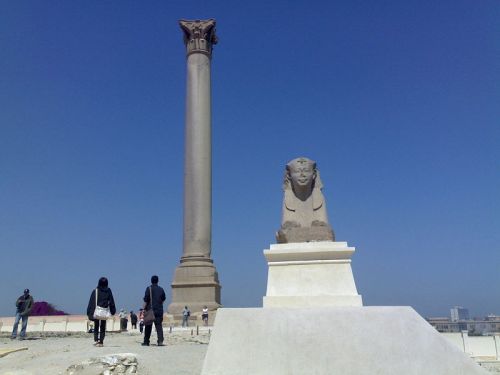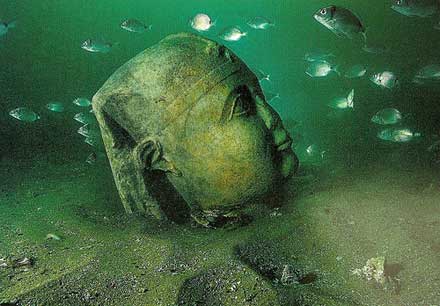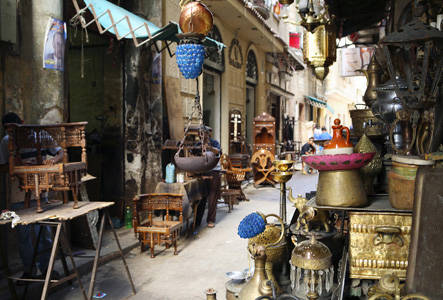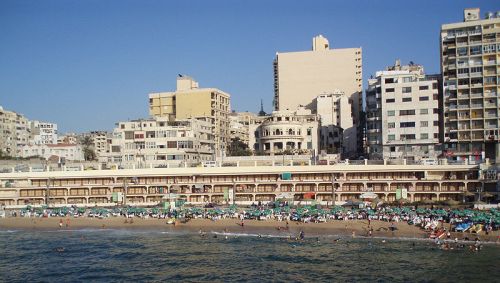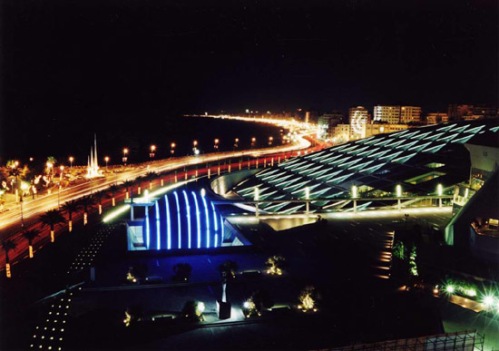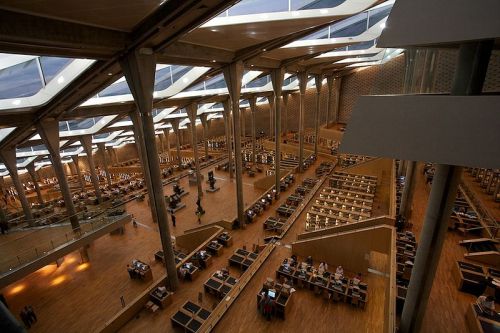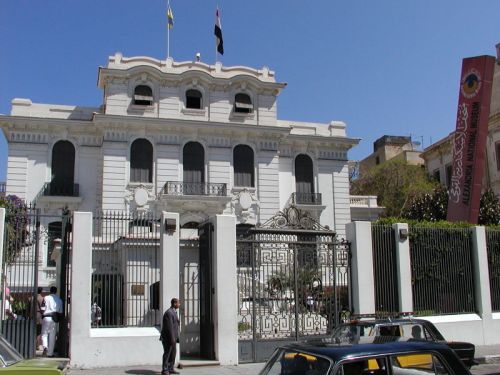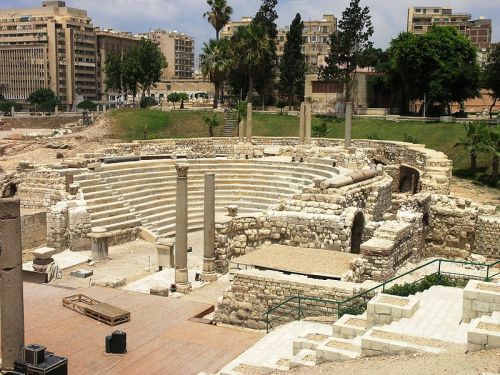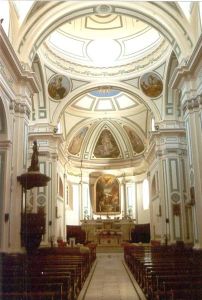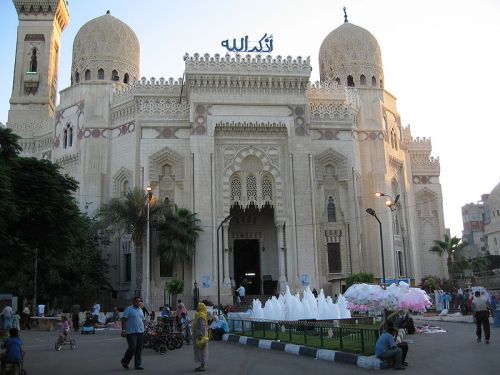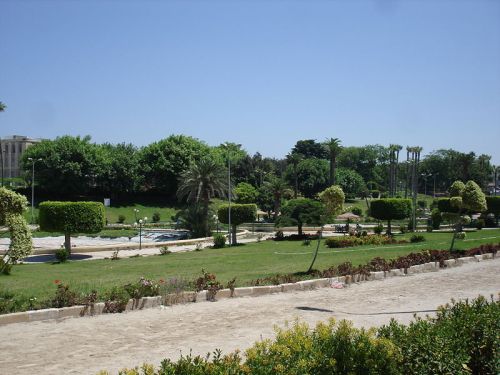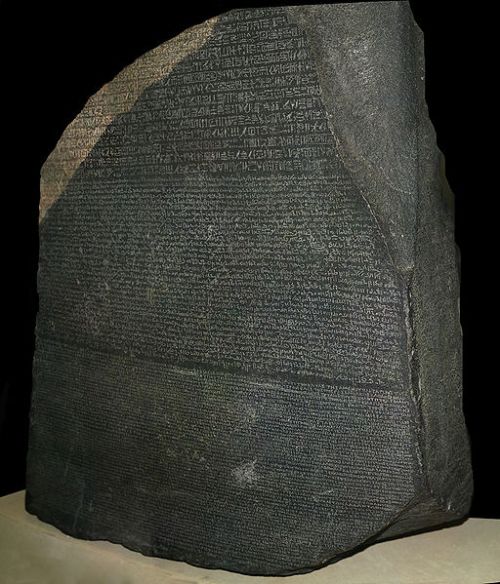Alexandria is Egypt’s second most important city, with a population of over 4,000,000. When Alexander the Great ordered the construction of a new capital of the country he had just conquered in 332 BC there was just a fishing village called Racotis here. Charged by Alexander to plan the new city (although some say Alexander laid it out using grain) Dinocrates of Rhodes connected Racotis to the island facing it – Pharos – by a dyke and causeway (the Heptastadion), forming two harbours. Alexander the Great never saw the new city named for him, Ptolemy I was the first king to live in and rule from Alexandria, while his successor, Ptolemy II turned it into the most important city in the Mediterranean. And so it remained until the times of the last of the dynasty, Queen Cleopatra VII.
Alexandria was designed by Dinocrates along the Greek or grid model. Surrounded by walls and supplied with water by a system of canals and cisterns, the city extended as far south as a great lake known as Mareotis although the very privileged had palaces built in the north on Cape Loquias near the harbour.
The greatest construction was the Lighthouse of Pharos (built during the reign of Philadelphus II and attributed to Sostratus of Cnidus), over 100 metres high and with a beacon that could be seen for around 50 kilometres. The lighthouse was lost after the Arab conquest and a number of earthquakes. If you go diving in the harbour it’s said that the tumbled blocks are still there to be seen under the water.
Alexandria was a Mediterranean city, a polyglot community of people from many Mediterranean countries, with the culture, cuisine and society to go with it. This has changed a little in more recent times but Alexandria still has all the hallmarks of its heritage.
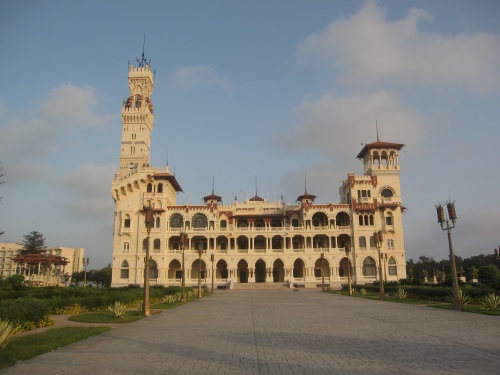
Al Montazah Palace at Alexandria. The larger Al-Haramlik Palace and royal gardens were added to the Montaza Palace grounds, being built by King Fuad I in 1932, as a summer palace. It is in a mixture of Turkish and Florentine styles, with has two towers, one rising distinctively high above with elaborated Italian Renaissance design details. The palace has long open arcades facing the sea along each floor.
Al-Montazah Palace
The palace is currently not open but the gardens are open to the public. The gardens are nice and shady with a central gazebo, lots of flowers, and there’s also a little beach which you can enjoy. A bridge allows you to walk across to the waterfront and watch the locals fishing or strolling. It’s a popular place for local Egyptians to enjoy a stroll and a picnic.
Pompey’s Pillar and the Serapeum
In the southwest of the city, Pompey’s pillar is an impressive column that stands around 29 meters, with a circumference of 9 m, and is made from a single shaft of red granite from Upper Egypt. Erected in 297 AD, Pompey’s pillar rises out of the ruins of the Serapeum, an acropolis erected in honour of Serapis. Mostly rubble, and a few sphinxes, the Serapeum isn’t much to look at, but the pillar is impressive and is the only remaining ancient monument in Alexandria that’s still intact.
Virtually nothing of the temple (or the church) remains on the site today, except for some above-ground rubble and an underground vault with niches that originally contained an annex of the Library of Alexandria. The sphinxes and “Pompey’s Pillar” on the site were not part of the Serapeum.
Kom el-Shuqafa (Catacombs)
Built in the late 1st century AD, the Kom el-Shuqafa (literally means “Mound of Shards”) is the largest known Roman burial site in Egypt and is a great underground cemetery dating to the 1st and 2nd centuries AD. Since the catacombs were built to house more than 300 dead notables, there are plenty of tombs to explore as well as a banqueting hall. Many of the rooms display a unique fusion of ancient Egyptian, Greek and Roman decorative artwork.
– The Catacombs are open from 9am – 5pm
– Situated near Pompey’s Pillar in the western part of Alexandria.
– No cameras allowed
Fort Qait Bey
Fort Qaitbey is an impressive building, located on a narrow peninsula where one of the ancient wonders of the world, the famous lighthouse — the Pharos — once stood. The Fort was originally built in the 15th century but was rebuilt in 1982 and now houses a naval museum. You’ll need about an hour to explore the rooms and towers, as well as the museum which houses some interesting weapons. The Fort also offers beautiful views of the city of Alexandria as well as the Mediterranean. Underwater archaeological investigations are being made in this area and have already discovered remnants from the lighthouse and other works and sculptures, including a great colossus thought to represent a king, a sphinx and a gigantic statue of the goddess Isis.
– Opening Times – 9am to 6pm in the summer
Alexandria Aquarium (near Fort Qait Bey) – opens 9.00am. Small entry fee.
The aquarium exhibits many species from the Mediterranean and Red Seas around Egypt, as well as some freshwater species from the Nile and the Amazon. Animals on display range from fish to crustaceans and turtles (both marine and freshwater). The Aquarium is also home to the Marine Research Institute.
The Necropolis of El Anfushi is located near the Eastern Harbour, in Ras El Tin area. There are five Greek rock-cut tombs that date back to the 2nd and the 3rd centuries, circa 250 BC. Built of alabaster and marble, these Ptolemaic tombs were only discovered in 1901 AD. At the site, two funeral constructions were discovered, each had two tombs.
The plan of the tombs is an open courtyard surrounded by chambers that contained one or more burials. As for the depictions, the tombs have scenes of Egyptian gods (such as Osiris, Isis, Horus and Anubis) decorated with multi-coloured geometric patterns and fine fresco ornaments.
In the two tombs of the first funeral building, there is a granite sarcophagus and a Pharaonic-styled burial chamber. A hole in this building leads to a cistern. One can proceed to reach the second funeral construction through staircase leading to a yard. Walls of the two tombs of this building are gracefully decorated with long fresco stripes and Pharaonic ornaments. The fifth and last funeral construction is considered the richest in decoration and relief. It has a rock-cut tomb, with a staircase and an open courtyard, from which one can view four small chambers.
Mustafa Kamel Tombs
These tombs are located in the Roman Camp street, Rushdi. They date from the Ptolemaic Era, as it was the site of August Caesar’s town with Roman barracks built to celebrate his Egyptian victory. There are four catacombs from the second century BC, distinguished by their bright colors and relief inscriptions that tell us about the daily activities and religious beliefs of the deceased. These tombs are similar in construction to those at El Anfushi and El Shatby. A unique subterranean rock-hewn tomb is the only tomb discovered east of Alexandria and is distinguished from the rest of the Ptolemaic tombs by its well preserved reliefs and architectural style.
El Shatby Necropolis
El Shatby Necropolis is located north of Saint Mark’s College, along the lines of the Old Greek houses, opposite the sea. It is the oldest in the city dating from Ptolemaic to Roman times. It comprises an entrance with a corridor, a front room and an interior one. Several parts for burial were added to it in later centuries. It dates from the 3rd Century BC, and is built on the ancient Greek house style.
Go diving
There are dive operations along the harbour and a chance to dive over some spectacular archaeological fields should not be missed if you are a diver. As well, there were major naval battles off Abu Qir in 1798 when the French fleet was routed by the English Navy led by the Admiral Horatio Nelson and in 1799 when the French defeated the Turks. The remains of the French fleet have been discovered on the sandy floor of the bay, in particular the admiral ship L’Orient which exploded during the battle with the loss of 1500 lives. As well, off the Abu Qir coastline are the remains of the ancient cities of Canopus (2 kms) and Herakleon (6 kms) which have yielded many important archaeological finds.
Drive along the Corniche
The Corniche is the road that runs along the eastern harbour of Alexandria and can also be the perfect place for a waterfront stroll. There are several restaurants where you can enjoy freshly caught fish so it’s also a good place to stop for lunch. You’ll pass some nice examples of Art Deco buildings like the (Sofitel) Cecil Hotel which has been enjoyed by the rich and famous. Or treat yourself to a Brazilian coffee, a shisha pipe or a hot glass of tea in some of Alexandria’s wonderful cafes.
Attarine Souk
The Attarine souk is a maize of little streets, too narrow for cars to fit, that houses literally hundreds of little antique shops and boutiques. It’s called the Zinqat as-Sittat market (which literally translates to ‘the women’s squeeze’). You’ll find some good deals to bargain for here. It’s an uncovered bazaar so it’s not so hot and stuffy.
Go to the beach
Alexandria has some excellent beaches and in summer these are incredibly popular. Be aware that as they are used a great deal by local Egyptians dress is significantly more modest than on Red Sea beaches. Stanley Beach and Maamoura are both very well known.
Maamoura is an area as well as a beach. It is considered one of the main tourist attractions of Alexandria due to its beautiful beach and parks. Famous spots in Maamoura Beach include:
Presidential Palace of Maamoura
Paradise Inn Resort
Maamoura Palace Hotel
Maamoura Plaza Mall
Kouta Park funfair
Alexandria Library — Bibliotheca Alexandrina
The famous Library of Alexandria was founded by Ptolemy I (with the help of a disciple of Aristotle called Demetrius of Phalerus) and enriched by Ptolemy II, setting out to purchase original manuscripts from all over the world, or to obtain a copy if this was not possible. Consequently it became the largest and most complete library in the world. Disaster struck around 49 BC when the library was destroyed by fire in the times of Julius Caesar. Eventually the great library became too small to house the works and a second was built, to which Cleopatra donated a collection of manuscripts given to her by Mark Anthony. This library was destroyed in the 4th century by Christians, along with the temple beside it, the Serapeum.
In 2002 a new library was constructed harking back to the great library of the 3rd century BC. The library houses books from all over the world, a museum and a planetarium. A small price allows you entrance to the library for a look around although the interior is not yet as impressive as the exterior as it only has a small collection. If you don’t have time to take the tour at least make a quick stop to look around outside.
National Museum
The national museum is located in a restored palace and contains about 1,800 artifacts that narrate the history of Alexandria throughout the ages. The museum consists of 3 levels – the basement housing the Pharaonic artefacts, the ground level displaying the Graeco-Roman treasures, and the 1st floor – containing relics from Egypt’s Coptic Christian and Islamic heritage, as well as some insight into the valuables left behind by King Farouk’s family before the 1952 revolution. The museum is housed in the old Al-Saad Bassili Pasha Palace.
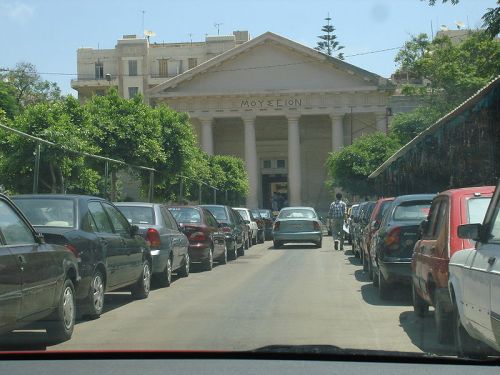
The Graeco-Roman Museum of Alexandria was created in 1892. It was first built in an 5-room apartment, inside one small building in Rosetta Street (later Avenue Canope and nowadays Horriya). In 1895, it was transferred to another building that only had eleven rooms. More rooms were added later to this building, now located near Gamal Abdul Nasser Street. There are a lot of pieces from the 3rd century BC, like a nice sculpture of Apis in black granite, the sacred bull of the Egyptians, mummies, sarcophagus, tapestries, and a lot of objects and sculptures that offer us a view of Graeco-Roman civilization in contact with Egypt. The museum is currently closed for renovation.
Graeco-Roman Museum
This Museum houses important pieces found in Alexandria and at other Egyptian sites. In Alexandria, Graeco-Roman and Pharaonic religions mingled in the cult of Serapis; the shift from pagan religions to Christianity can also be seen in the exhibits which include mummies, Hellenistic statues, busts of Roman emperors, Tangara figurines, and early Christian antiquities. It has been closed for some time for renovation and is not likely to reopen until 2013.
Museum of Fine Arts
Southeast of the Graeco-Roman Museum, beyond the railroad lines leading to the Main Railway Station, located along Mansha Street, is the Museum of Fine Art housing Egyptian and European painting of the 16th-19th centuries. The Museum has a large collection of paintings, sculptures and architectural works (around 1,500 pieces). Regular exhibitions of paintings and sculptures by budding artists make it a remarkable art destination.
The Museum dates back to 1954, when it was built on land gifted to the city’s governorate. It was previously known as the ‘Hussein Sobhy Museum’, after the governor of Alexandria who was once an important part of the city’s strong arts movement. The museum also hosts the Alexandria Biennial, when Mediterranean art works are displayed in a special exhibition.
Museum of Fine Arts, Alexandria is open: Tuesday to Sunday – 10:00 to 18:00
Admission: free
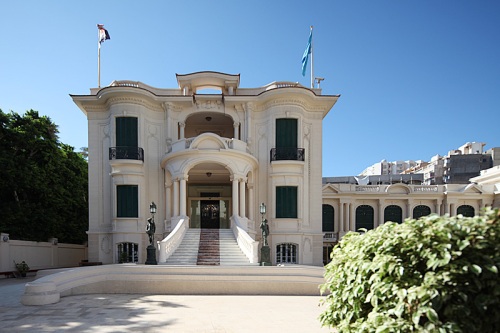
The Royal Jewelry Museum is an art and history museum in the Zizenia neighborhood of Alexandria, Egypt. It is located in the former palace of Princess Fatma Al-Zahra'. Its halls contain an inestimable collection of jewels and jewelry of the Muhammad Ali Dynasty. 19th century paintings, statues, and decorative arts are also exhibited in the rooms and lobbies. The museum was first inaugurated on 24 October 1986.
Royal Jewelry Museum
Also of interest in Alexandria is the Royal Jewelry Museum, which has become known not only for its fine jewellery and precious treasures, but also for its ancient paintings.
Of interest to those who have a penchant for jewellery, this specialist museum is situated in the Zizinia district. Formerly the palace of Fatma el-Zahara, the building is architecturally interesting and the interior decoration striking, as interesting as the items displayed. Inside are many rare paintings, statues and decorations as well as the enormous royal collection of jewels from the Mohamed Ali Dynasty.
The rooms of the two floors are filled to the brim with display boxes showcasing every kind of imaginable item of status, luxury and wealth. The most important pieces in the collection are the royal crowns and tiaras.
The small well-stocked souvenir shop sells cards, books on the different eras of Egyptian history, and brightly coloured gift items at reasonable prices.
The Jewelry Museum is open daily from 9am to 4pm except on Fridays when it opens from 10am to 11.30am and from 1.30pm to 4pm. At the moment the Museum is closed for renovation.
There is an admission charge of 40LE.
Kom el-Dikka is a Roman amphitheatre that isn’t huge, but very well preserved nevertheless, the only one like this in Egypt. Excavation continues nearby to reveal the remains of a Roman city that dates from the time of Tiberius. The amphitheatre is a nice place to visit and relax. It’s open from 9am – 4pm and is situated on the Raml Station Square.
Villa of the Birds
Also at Kom el Dikka, this Roman villa is so named because of the vibrant floor mosaics.
Churches
Today, the patriarchal seat of the Pope of the Coptic Orthodox Church is Saint Mark Cathedral in Ramleh. The most important Coptic Orthodox churches in Alexandria include Pope Cyril I Church in Cleopatra, Saint Georges Church in Sporting, Saint Mark & Pope Peter I Church in Sidi Bishr, Saint Mary Church in Assafra, Saint Mary Church in Gianaclis, Saint Mina Church in Fleming, Saint Mina Church in Mandara, and Saint Takla Haymanot’s Church in Ibrahimeya.
The most important Greek Orthodox churches in Alexandria are Saint Anargyri Church, Church of the Annunciation, Saint Anthony Church, Archangels Gabriel & Michael Church, Saint Catherine Church, Cathedral of the Dormition in Mansheya, Church of the Dormition, Prophet Elijah Church, Saint Georges Church, Church of the Immaculate Conception in Ibrahemeya, Saint Joseph Church in Fleming, Saint Joseph of Arimathea Church, Saint Mark & Saint Nectarios Chapel in Ramleh, Saint Nicholas Church, Saint Paraskevi Church, Saint Sava Cathedral in Ramleh, and Saint Theodore Chapel. In communion with the Greek Orthodox Church is the Russian Orthodox church of Saint Alexander Nevsky in Alexandria, which serves the Russian speaking community in the city.
Churches that follow the Latin Catholic rite include Saint Catherine Church in Mansheya and Church of the Jesuits in Cleopatra.
The Saint Mark Church in Shatby, found as part of Collège Saint Marc is multi-denominational and hold liturgies according to Latin Catholic, Coptic Catholic and Coptic Orthodox rites.
Mosques
The most famous mosque in Alexandria is El-Mursi Abul Abbas Mosque in Bahary. Other notable mosques in the city include Ali ibn Abi Talib mosque in Somouha, Bilal mosque, al-Gamaa al-Bahari in Mandara, Hatem mosque in Somouha, Hoda el-Islam mosque in Sidi Bishr, al-Mowasah mosque in Hadara, Sharq al-Madina mosque in Miami, al-Shohadaa mosque in Mostafa Kamel, Al Qa’ed Ibrahim Mosque, Yehia mosque in Zizinia, Sidi Gaber mosque in Sidi Gaber, and Sultan mosque.
Take a walk in a park
As well as the beautiful and popular Montazah Gardens there is also Shallalt Park and the Antoniades Park. Shallalat Gardens is the name of an ancient garden which occupies a big area of Al Shatby neighborhood. Parts of the ancient Alexandria Wall are still present at the gardens. The Antoniades Park has an English Garden and a French Garden and some outstanding statuary examples.
Birdwatching
Lake Mariut, which was once a vast basin, has decreased in size to a great degree, becoming a marshy zone with some picturesque spots where numerous birds come to nest. Despite being divided up by roads and rail and for fish farms, and despite the high pollution level, Lake Mariut abounds in animals and plants. The banks, covered with reeds, are nesting grounds for many species, including little grebes, little bittern, Kentish plover, purple gallinule and moorhen.
Philoxenite
Founded on the southern shore of Lake MAriut, the city of Philoxenite was a vast, rich city whose remains are still quite impressive and fascinating. They lie southeast of Abusir and date from the 5th-6th centuries AD. The large site is easily recognisable from a distance because of an arch that was probably part of a construction housing a grain mill and the fours large quays extending into the lake, which in ancient times were probably used to berth cargo ships or boats carrying pilgrims for the nearby St. Menas Monastery.
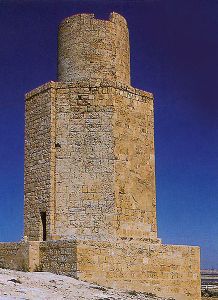
A well-preserved ancient tomb is thought to be a scaled-down model of the Alexandria Pharos. Known colloquially under various names — the Pharos of Abusir, the Abusir funerary monument and Burg al-Arab (Arab's Tower) — it consists of a 3-story tower, approximately 20 metres (66 ft) in height, with a square base, a hexagonal midsection and cylindrical upper section, like the building upon which it was apparently modelled. It dates to the reign of Ptolemy II (285–246 BC), and is therefore likely to have been built at about the same time as the Alexandria Pharos.
Abusir
The seaside town of Abu Sir, 20 kms west of Alexandria, has the only ancient lighthouse in Egypt. Although it was a funerary monument, the pharos can be considered a replica of the famous ancient one at Alexandria. The locals call it Burg al Arab (the Arab’s Tower) and the name is also used to name the present-day town in the vicinity. There is also a large Ptolemaic temple dedicated to Osiris.
Zahi Hawass and Kathleen Martinez have excavated the vicinity of the Temple of Isis since 2006. They found a carved male head and a partial mask, showing cleft chin reminiscent of Mark Antony, besides a stash of coins bearing the image of Cleopatra VII. Relying on these and the account of Plutarch, they believe that Cleopatra and Mark Antony are both buried in the vicinity, most likely below the Temple of Isis.
Nearby
The St Menas Monastery
The ruins of the ancient monastery of St Menas constitute a major archaeological site that has been included in the UNESCO World Heritage List. The archaeological site is about 2 kms south of the modern monastery, which is in turn about 10 kms south of the city of Burg al Arab. It includes the remains of a large sanctuary of the 5th and 6th centuries. The precinct includes the main basilica known as the Great Basilica, a martyrium, a baptistery, baths and the north and east basilicas. The large modern monastery built in 1959 for the Patriarch Cyril VI, is a popular pilgrimage site.
Rashid National Museum
The Rashid (Rosetta) National Museum (65 km east of Alexandria) stands waiting for visitors after being restored and returned to its original pristine condition. The museum is installed in one of Rashid’s famous stately Ottoman houses, the Arab Killy house. The house was named after a Turkish trader called Hussein Arab Kulli, who lived there in the early 18th Century. It was the largest house in Rosetta. The first floor was used for receptions; the second was where the family lived and where Kulli had his office and the third contained the haramlik (women’s quarters). Restoration of the museum led to the discovery of a small gravure and a very fine piece of Kufic calligraphy.
The museum’s exhibits relate the history of Rashid from the town’s construction in ancient times right through to the modern era. On display are 600 artefacts carefully selected from the Islamic and Coptic museums and the Gayer Anderson house in Cairo, along with another 200 objects unearthed from archaeological sites around Rashid. These include a collection of Omayyad and Ottoman gold and bronze coins, pots and pans, versions of the holy Quran and a collection of 18th and 19th century weapons such as arrows, swords, knives and pistols. Tapestry, military and national Ottoman and Mameluk costumes are also exhibited.
To give visitors an idea of what an Ottoman house looked liked, some halls of the museum have been furnished with complete sets of Ottoman furniture. The highlight of the museum is a life-size replica of the Rosetta Stone, offered by the British Museum in response to an official request to the Museum’s Ancient Egyptian Department for return of the original. The replica stone is on display at the foyer of the museum.

